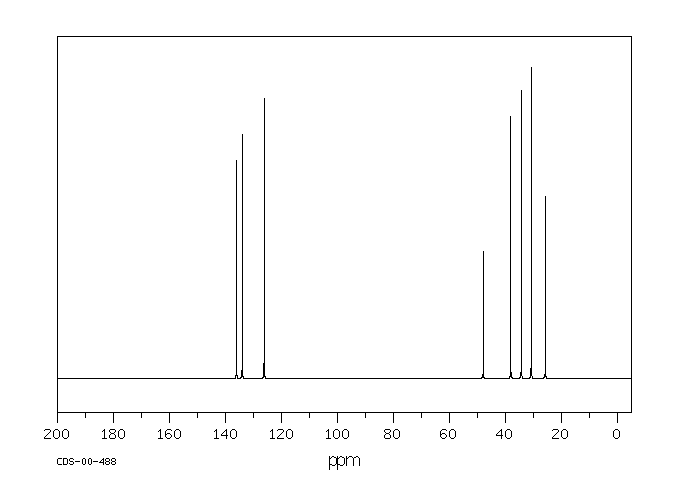1,2,3,3A,4,5,5A,6,7,8-十氢芘 | 14698-02-3
中文名称
1,2,3,3A,4,5,5A,6,7,8-十氢芘
中文别名
——
英文名称
1,2,3,3a,4,5,5a,6,7,8-decahydropyrene
英文别名
1,2,3,3a,4,5,5a,6,7,8-decahydro-pyrene;1,2,3,3a,4,5,5a,6,7,8-Decahydro-pyren;1,2,3,4,5,6,7,8,12,13-decahydro-pyrene;1,2,3,3a,4,5,5a,6,7,8-Decahydropyren;1,2,3,3a,4,5,5a,6,7,8-Dekahydropyren
CAS
14698-02-3;69618-53-7;69618-54-8
化学式
C16H20
mdl
——
分子量
212.335
InChiKey
MNXFZXVRYXNOBW-UHFFFAOYSA-N
BEILSTEIN
——
EINECS
——
-
物化性质
-
计算性质
-
ADMET
-
安全信息
-
SDS
-
制备方法与用途
-
上下游信息
-
文献信息
-
表征谱图
-
同类化合物
-
相关功能分类
-
相关结构分类
物化性质
-
熔点:34 °C
-
沸点:335.6±37.0 °C(Predicted)
-
密度:1.063±0.06 g/cm3(Predicted)
计算性质
-
辛醇/水分配系数(LogP):5.1
-
重原子数:16
-
可旋转键数:0
-
环数:4.0
-
sp3杂化的碳原子比例:0.62
-
拓扑面积:0
-
氢给体数:0
-
氢受体数:0
上下游信息
-
上游原料
中文名称 英文名称 CAS号 化学式 分子量 1,2,3a,3,4,5-六氢芘 1,2,3,3a,4,5-hexahydropyrene 5385-37-5 C16H16 208.303
反应信息
-
作为反应物:参考文献:名称:Treibs; Mann, Chemische Berichte, 1958, vol. 91, p. 1910,1915摘要:DOI:
-
作为产物:描述:参考文献:名称:多环芳烃在熔盐催化剂上的加氢裂化摘要:研究了分批高压釜系统中菲、蒽、芘、芘和荧蒽在 400 °C 下在熔盐催化剂上的加氢裂化。产物主要通过 GC-MS 进行鉴定,但代表性产物通过制备型 GLC 进行分离,并使用 NMR、IR、UV 和质谱法进行表征。大多数分离出的产物是先前未详细证实的化合物,尽管在相应的芳族化合物的加氢裂化过程中预计会形成它们。根据产品分布提供可能的反应路线。氯化锌和氯化铜 (I) 的二元混合物被认为是一种熔融的双功能催化剂。DOI:10.1246/bcsj.51.618
文献信息
-
Quenched skeletal Ni as the effective catalyst for selective partial hydrogenation of polycyclic aromatic hydrocarbons作者:Chengyun Liu、Zeming Rong、Zhuohua Sun、Yong Wang、Wenqiang Du、Yue Wang、Lianhai LuDOI:10.1039/c3ra44871a日期:——Quenched skeletal Ni is an active and selective catalyst for selective partial hydrogenation of polycyclic aromatic hydrocarbons (PAHs). The molecular structure of PAHs significantly dominate the hydrogenation process and furthermore, the distribution of hydrogenated products.淬灭的骨架Ni是一种用于多环芳烃(PAHs)选择性部分加氢的活性和选择性催化剂。PAHs的分子结构显着支配了氢化过程,此外还决定了氢化产物的分布。
-
Facile sonochemical synthesis of carbon nanotube-supported bimetallic Pt–Rh nanoparticles for room temperature hydrogenation of arenes作者:Horng-Bin Pan、Chien M. WaiDOI:10.1039/c1nj20028c日期:——Bimetallic Pt–Rh nanoparticles can be deposited uniformly on surfaces of carboxylate functionalized multi-walled carbon nanotubes (MWNTs) using a simple one-step sonochemical method. The bimetallic nanoparticle catalyst exhibits a strong synergistic effect relative to the individual Pt or Rh metal nanoparticles for catalytic hydrogenation of polycyclic aromatic hydrocarbons (PAHs), neat benzene and
-
Hydrogenation of Pyrene and Catalytic Interconversion of Hydropyrenes作者:Masahiro Minabe、Katsuko NakadaDOI:10.1246/bcsj.58.1962日期:1985.7reference to the hydrogenations of 2–5: 4 may be formed independent of 2, and 2 is converted to 3. Hydropyrene 5 may be produced from 1 mainly through the same σ-adsorbed species which also leads to 2. The hydrogenation of 1 with palladium and platinum catalysts gave similar results as with nickel. With nickel and palladium catalysts the hydrogenation of 1 was faster than that of 4H-cyclopenta[def]phenanthrene在常压下用阮内镍催化剂对芘 (1) 加氢进行再研究,得到 4,5-二-(2)、4,5,9,10-四-(3)、1,2,3, 6,7,8-六- (4) 和 1,2,3,3a,4,5-六氢芘 (5)。初始反应阶段每种产物的相对量由产物的时间-产率关系确定。产物的形成顺序参考 2-5 的氢化作用进行讨论:4 可能独立于 2 形成,2 转化为 3。 氢芘5 可能主要通过相同的 σ 吸附物质从 1 产生导致 2。1 用钯和铂催化剂加氢得到与镍相似的结果。使用镍和钯催化剂,1 的氢化比 4H-环戊二烯的氢化速度快 (9)。然而,对于铂,1 的氢化比 9 慢。在 240 °C 和 90 kg cm-2 的氩气压力下检查 2-5 的催化互变。氢芳烃2很容易脱氢...
-
Das ESR.-Spektrum der 1,2,3-Trihydropyrenyls作者:F. Gerson、E. Heilbronner、H. A. Reddoch、D. H. Paskovich、N. C. DasDOI:10.1002/hlca.19670500308日期:1967.4.20The two isomeric tetrahydropyrenes II and III have been prepared by Birch reduction of pyrene. Air oxidation of either compound yields 1,2,3-trihydropyrenyl (1,9-trimethylene-phenalenyl; IV); its ESR. hyperfine structure is shown to be closely related to that of phenalenyl.
-
264. Studies in tar hydrocarbons. Part I. Reduction products of pyrene作者:Edward A. CoulsonDOI:10.1039/jr9370001298日期:——
表征谱图
-
氢谱1HNMR
-
质谱MS
-
碳谱13CNMR
-
红外IR
-
拉曼Raman
-
峰位数据
-
峰位匹配
-
表征信息
同类化合物
(R)-2,2'',3,3''-四氢-6,6''-二-9-菲基-1,1''-螺双[1H-茚]-7,7''-二醇
(6,6)-苯基-C61己酸甲酯
高雌二醇
马兜铃酸钠
马兜铃酸盐
马兜铃酸C
马兜铃酸B
马兜铃酸(1:1MIXTUREOFARISTOLOCHICACIDIANDARISTOLOCHICACIDII)
马兜铃酸 Ia
马兜铃酸 IVa
马兜铃酸
颜料黑32
颜料红179
颜料红178
颜料红149
颜料红123
顺式-菲-1,2-二醇-3,4-环氧化物
顺式-苯并(a)屈-11,12-二醇-13,14-环氧化物
雷公藤酚A
镁二(1,4,5,6,7,16,17,18,19,19,20,20-十二氯六环[14.2.1.14,7.02,15.03,8.09,14]二十-5,9,11,13,17-五烯-11-磺酸酯)
钩大青酮
钩大青酮
钙(2+)12-羟基十八烷酸酯
酒石酸布托诺啡
那布扶林
还原红32
足球烯
贝那他汀B
贝母兰素
萘并[2,3-b]荧蒽
萘并[2,1-e][1]苯并二硫杂环戊烷
萘并[2,1-C:7,8-C']二菲
萘并[1,2-e][2]苯并呋喃-1,3-二酮
萘并[1,2-b]屈
萘并[1,2-a]蒽
萘并[1,2-B]菲-6-醇
萘二(六氯环戊二烯)加合物
萘,8-溴-1,2,3-三(1,1-二甲基乙基)-6-甲基-
菲醌单缩氨基硫脲
菲醌
菲并[9,10]呋喃
菲并[9,10-e]醋菲烯
菲并[4,5-bcd]噻吩
菲并[4,5-bcd]呋喃-3-醇
菲并[4,3-d]-1,3-二噁唑-5-羧酸,10-羟基-9-甲氧基-6-硝基-
菲并[3,2-b]噻吩
菲并[2,1-d]噻唑
菲并[2'',1'',10'':4,5,6;7'',8'',9'':4',5',6']二异喹啉并[2,1-a:2',1'-a']二萘嵌间二氮杂苯-8,13-二酮
菲并(3,4-b)噻吩
菲并(1,2-b)噻吩







